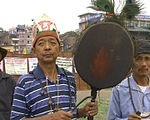Related Research Articles

The heart is a muscular organ in most animals, which pumps blood through the blood vessels of the circulatory system. The pumped blood carries oxygen and nutrients to the body, while carrying metabolic waste such as carbon dioxide to the lungs. In humans, the heart is approximately the size of a closed fist and is located between the lungs, in the middle compartment of the chest.

A heart valve is a one-way valve that normally allows blood to flow in only one direction through the heart. The four valves are commonly represented in a mammalian heart that determines the pathway of blood flow through the heart. A heart valve opens or closes incumbent on differential blood pressure on each side.
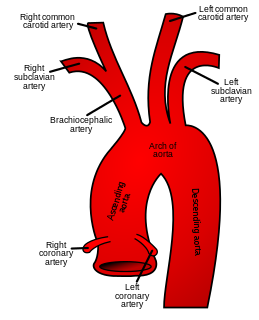
In human anatomy, the subclavian arteries are paired major arteries of the upper thorax, below the clavicle. They receive blood from the aortic arch. The left subclavian artery supplies blood to the left arm and the right subclavian artery supplies blood to the right arm, with some branches supplying the head and thorax. On the left side of the body, the subclavian comes directly off the aortic arch, while on the right side it arises from the relatively short brachiocephalic artery when it bifurcates into the subclavian and the right common carotid artery.

The shamisen or samisen (三味線), also sangen, is a three-stringed traditional Japanese musical instrument derived from the Chinese instrument sanxian. It is played with a plectrum called a bachi.

A pulmonary artery is an artery in the pulmonary circulation that carries deoxygenated blood from the right side of the heart to the lungs. The largest pulmonary artery is the main pulmonary artery or pulmonary trunk from the heart, and the smallest ones are the arterioles, which lead to the capillaries that surround the pulmonary alveoli.
The sanshin is an Okinawan musical instrument and precursor of the mainland Japanese shamisen ( 三味線). Often likened to a banjo, it consists of a snakeskin-covered body, neck and three strings.

The mridangam is a percussion instrument of ancient origin. It is the primary rhythmic accompaniment in a Carnatic music ensemble, and in Dhrupad, where the same instrument is referred to as pakhawaj. A related instrument is the Kendang, played in Maritime Southeast Asia.
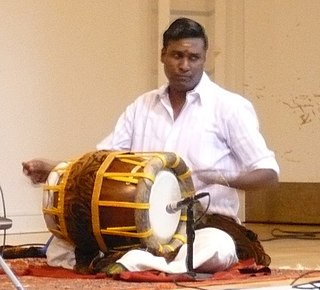
A thavil (Tamil:தவில்) or tavil is a barrel-shaped percussion instrument from Tamil Nadu. It is used in temple, folk and Carnatic music, often accompanying the nadaswaram. The thavil and the nadaswaram are essential components of traditional festivals and ceremonies in South India.
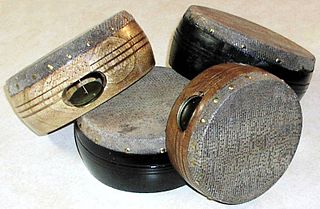
The kanjira, khanjira, khanjiri or ganjira, a South Indian frame drum, is an instrument of the tambourine family. As a folk and bhajan instrument, it has been used in India for many centuries. It was modified to a frame drum with a single pair of jingles by Manpoondia Pillai in the 1880s, who is credited with bringing the instrument to the classical stage. It is used primarily in concerts of Carnatic music as a supporting instrument for the mridangam.

In Trinidad and Tobago and other parts of the Caribbean, the term "tassa" refers to a drumming ensemble drawn from an amalgamation of various of North Indian folk drumming traditions, most importantly dhol-tasha, a style that remains popular today in many parts of India and Pakistan. Beginning in the 1830s and lasting until 1918, dhol-tasha was taken around the world by Indian workers, mostly from present-day Bihar and Uttar Pradesh, enmeshed in a global scheme of indentured labor in British, French, and Dutch territories.

In anatomy, the left and right common carotid arteries (carotids) are arteries that supply the head and neck with oxygenated blood; they divide in the neck to form the external and internal carotid arteries.

Bombo legüero is an Argentine drum traditionally made of a hollowed tree trunk and covered with cured skins of animals such as goats, cows (leather) or sheep; legüero signifies that you can supposedly hear it a league away. It derives from the old European military drums, and uses a similar arrangement of hoops and leather thongs and loops to tighten the drumheads, which are usually double. It is also called bombo legüero to differentiate it from similar large drums. The body is made of a hollow log, with the inside scraped and chiseled. The drumheads are made of the skins of animals such as cows, sheep, or guanacos. Because the fur is left on the hide, the bombo’s sound is deep and dark. The bombo is played while hanging to the side of the drummer, who drapes one arm over the drum, to play it from above, while also striking it from the front. The player’s hands hold a soft-headed mallet and a stick, which strike drumhead and wooden rim in alternation. The bombo serves as a combination of bass and percussion, not just maintaining the meter, but evoking an elemental, visceral response. The legüero is an essential element of Argentine Folclore popularized by musicians like Los Chalchaleros, Tremor, Los Fronterizos, Carlos Rivero, Soledad Pastorutti, and Mercedes Sosa.

The Chanda is a cylindrical percussion instrument used widely in the state of Kerala, Tulu Nadu of Karnataka and Tamil Nadu in India. In Tulu Nadu, it is known as chende. It is greatly identified as a cultural element in Kerala.
The pakhavaj is a barrel-shaped, two-headed drum, originating from the Indian subcontinent, a variant and descendant of the older mridang. The kendang of Maritime Southeast Asia is a distant relation of the pakhawaj and other South Asian double-headed drums.
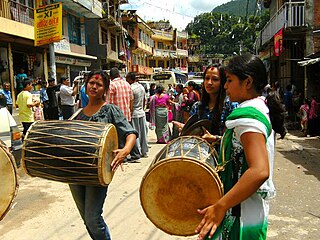
Dhimay, Dhimaya or Dhime (धिमे) is a drum, and according to the Sachs-Hornbostel classification belongs to the category of double-headed cylindrical membranophone.
The Dhaa is a two-headed drum, "slightly smaller than the Dhimay." It belong to the membranophone group of Newar traditional musical instruments. It is a kind of drum specially played during the month of Gunlaa, the ninth month of Newar calendar. Dhaa is also known as "Gunlaa Baajan".
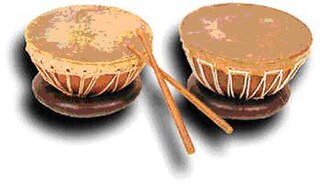
Kudüm is one of the most fundamental rhythm instruments in classical Turkish music. The person playing it is called kudümzen. It is among ney, rebap, and halile as one of the four main instruments in Mevlevi music. It consists of a pair of small, hemispherical drums. Traditionally kudüm was played in religious ceremonies; in a secular context, like in mehter music, its slightly bigger cousin nakkare is played.

The Maddale also called Mrudanga(ಮೃದಂಗ) in North Canara region is a percussion instrument from Karnataka, India. It is the primary rhythmic accompaniment in a Yakshagana ensemble along with Chande. Maddale also represents a remarkable progress in percussive instruments as it produces the perfectly hormonic tonic when played anywhere on the surface compared to Mrudangam, Pakawaj or Tabla that can not produce the tonic (shruti) on all parts of the drum surface. The traditional variety of Maddale was 30 cm long, had 8 inch drum head for right and produced the louder sound. These days 6 - 6.5 inch wide right side maddale is used with only a few using 7 inch wide. Left bass side is about an inch bigger than right. Maddale is available in more than three different variations. Maddale used in Yakshagana looks similar to mridangam but is markedly different in structure, acoustics, playing techniques and the rhythm system.

The bodhrán, is a frame drum of Irish origin ranging from 25 to 65 cm (10–26 in) in diameter, with most drums measuring 35–45 cm (14–18 in). The sides of the drum are 9–20 cm deep. A goatskin head is tacked to one side. The other side is open-ended for one hand to be placed against the inside of the drum head to control the pitch and timbre.

Uruttu Chenda is a type of "Chenda" or drum used to play variations in Chenda music. It is used to lead the orchestra. It is called the ""Pramanavadhya"". The "Chenda Vattam" of the "Uruttu Chenda" is always the "Edam Thala" or the "Left Head" which is made of soft, single cow skin. The meaning of "uruttu" in Malayalam language is "rolling". The artist produce sound on "Uruttu Chenda" by rolling his right hand wrist. During the first beat the palm holding the stick will face the artist (in), then during the second beat the palm would face the opposite side (out). This is done by rolling the wrist.
References
- Matt Dean (2012). The Drum: A History. Scarecrow Press. p. 110. ISBN 978-0-8108-8170-9.
| This article relating to musical instruments is a stub. You can help Wikipedia by expanding it. |
